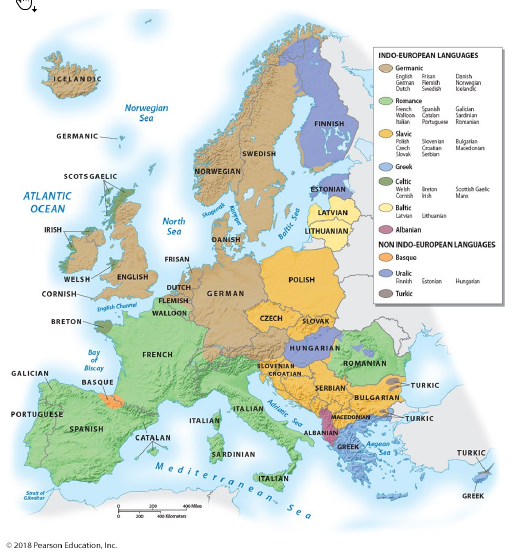Describe the major language families present in Europe. How do groups within these families use language to differentiate themselves culturally?

What will be an ideal response?
Language is an important source of nationalism in Europe, but most Europeans speak more than one language. Germanic languages dominate the northern region, with German spoken by the most people and English a close second. Dutch and Flemish and Scandinavian languages are also part of the Germanic language family. The southern portion of the continent is dominated by Romance languages which evolved from common Latin, spoken during the Roman Empire. Italian has the most speakers of this language family?spoken not only in Italy but parts of Switzerland and on the French island of Corsica. French is also spoken beyond the political boundaries of France?in Switzerland and southern Belgium. Spanish is also an important part of the Romance language family in Europe, but has many distinctive regional variations. These variations are associated with unique cultural groups?Castilian Spanish, and Catalan. This idea of cultural difference has even led to Catalonia being given autonomous status within Spain. Portuguese and Romanian are the other two important Romance Languages, however, Romanian borrows many words from neighboring Slavic languages. Slavic languages, spoken throughout Eastern Europe, are distinctly divided based on the alphabet used to write them. Polish, Slovakian, and Czech are written using the Latin alphabet while southern Slavic languages such as Serbian and Bulgarian are written using the Cyrillic alphabet.
You might also like to view...
Which of the following statistics cannot be used in a neighborhood operation?
A. mean B. maximum C. majority D. minority E. none of these are correct
When forests are cut down, most of this in the trees is released to the atmosphere, through decomposition or perhaps fire
A) carbon B) sulfur C) nitrogen D) neon E) oxygen
Which of the following is true?
A) The Sun emits shortwave radiation, whereas Earth emits longwave radiation. B) The Sun emits longwave radiation, whereas Earth emits shortwave radiation. C) During the summer, the Sun emits shortwave radiation, while during the winter the Sun emits longwave radiation. D) The radiation emitted by the Sun and Earth are roughly the same wavelength. E) Because the Sun is so far away, it is impossible to measure the wavelengths of its radiation.
A mirage that changes the apparent size of an object is called:
A) towering. B) magnification. C) looming. D) dispersion.